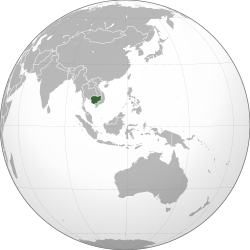
Back جمهورية كمبوتشيا الشعبية Arabic Народная Рэспубліка Кампучыя Byelorussian Народна република Кампучия Bulgarian República Popular de Kamputxea Catalan Kampučská lidová republika Czech Volksrepublik Kampuchea German Popola Respubliko Kamboĝa Esperanto República Popular de Kampuchea Spanish Kanputxeako Herri Errepublika Basque جمهوری خلق کمپوچیا Persian
People's Republic of Kampuchea | |||||||||
|---|---|---|---|---|---|---|---|---|---|
| 1979–1989 | |||||||||
| Motto: ឯករាជ្យ សន្តិភាព សេរីភាព សុភមង្គល[1] Êkâréachy, Sântĕphéap, Sériphéap, Sŏphômôngkôl "Independence, Peace, Liberty, Happiness" | |||||||||
| Anthem: បទចម្រៀងនៃសាធារណរដ្ឋប្រជាមានិតកម្ពុជា Bât Châmriĕng ney Sathéarânârôdth Brâchéaméanĭt Kâmpŭchéa "Anthem of the People's Republic of Kampuchea" | |||||||||
 Location of the People's Republic of Kampuchea | |||||||||
| Status | |||||||||
| Capital and largest city | Phnom Penh | ||||||||
| Official languages | Khmer | ||||||||
| Other languages | Vietnamese | ||||||||
| Religion | State secularism[2][1] | ||||||||
| Government | Unitary Marxist–Leninist one-party socialist republic | ||||||||
| General Secretary | |||||||||
• 1979–1981 | Pen Sovan | ||||||||
• 1981–1989 | Heng Samrin | ||||||||
| Chairman of the State Council | |||||||||
• 1979–1989 | Heng Samrin | ||||||||
| Prime Minister | |||||||||
• 1981 | Pen Sovan | ||||||||
• 1982–1984 | Chan Sy | ||||||||
• 1985–1989 | Hun Sen | ||||||||
| Legislature | National Assembly | ||||||||
| Historical era | Cold War | ||||||||
| 7 January 1979 | |||||||||
• Establishment | 8 January 1979 | ||||||||
• Constitution | 25 June 1981 | ||||||||
• K5 Plan | 1985 | ||||||||
• Transition | 1 May 1989 | ||||||||
| Population | |||||||||
• 1980 | 6,600,000[3] | ||||||||
| Currency | Kampuchean riel (from 1980) Vietnamese đồng (until 1980) | ||||||||
| Time zone | UTC+07:00 (ICT) | ||||||||
| Date format | dd/mm/yyyy | ||||||||
| Drives on | Right | ||||||||
| Calling code | +855 | ||||||||
| |||||||||
| Today part of | Cambodia | ||||||||
| History of Cambodia |
|---|
| Early history |
| Post-Angkor period |
| Colonial period |
| Independence and conflict |
| Peace process |
| Modern Cambodia |
| By topic |
|
|
The People's Republic of Kampuchea (PRK)[a] was a partially recognised state in Southeast Asia which existed from 1979 to 1989. It was a satellite state of Vietnam, founded in Cambodia by the Vietnamese-backed Kampuchean United Front for National Salvation, a group of Cambodian communists who were dissatisfied with the Khmer Rouge due to its oppressive rule and defected from it after the overthrow of Democratic Kampuchea, Pol Pot's government. Brought about by an invasion from Vietnam,[4][5] which routed the Khmer Rouge armies, it had Vietnam and the Soviet Union as its main allies.
The PRK failed to secure United Nations endorsement due to the diplomatic intervention of China, the United Kingdom, the United States and the ASEAN countries. The Cambodian seat at the United Nations was held by the Coalition Government of Democratic Kampuchea, which was the Khmer Rouge in coalition with two non-communist guerrilla factions. However, the PRK was considered the de facto government of Cambodia between 1979 and 1992, albeit with limited international recognition outside of the Soviet Bloc.
Beginning May 1989, the PRK restored the name "Cambodia" by renaming the country State of Cambodia (SOC) during the last four years of its existence in an attempt to attract international sympathy.[6] However, it retained most of its leadership and one-party structure while undergoing a transition and eventually giving way to the restoration of the Kingdom of Cambodia. The PRK/SOC existed as a communist state from 1979 until 1991, the year in which the ruling single party abandoned its Marxist–Leninist ideology.
Under Vietnamese control, the PRK was established in the wake of the total destruction of the country's institutions, infrastructure and intelligentsia wreaked by Khmer Rouge rule.[7]
- ^ a b "Constitution of the People's Republic of Kampuchea" (PDF) (in Khmer). Constitutional Council of Cambodia. 25 June 1981. Archived from the original (PDF) on 10 July 2021. Retrieved 10 July 2021.
- ^ "Cambodia – Religion". Encyclopaedia Britannica. Retrieved 29 June 2020.
- ^ "Results of the 1998 Population Census in Cambodia". Asia-Pacific Population Journal. September 2000. Archived from the original on 28 April 2021. Retrieved 11 August 2019.
- ^ Boyle, Kevin (14 September 2014). "Vietnam's forgotten Cambodian war". BBC News.
- ^ "Cambodia – Vietnamese Occupation – 1979–1989". Global Security.
- ^ Michael Leifer, Dictionary of the modern politics of South-East Asia
- ^ Sorpong Peou, Intervention & change in Cambodia; Towards Democracy?, ISBN 0-312-22717-5, 978-0312227173
Cite error: There are <ref group=lower-alpha> tags or {{efn}} templates on this page, but the references will not show without a {{reflist|group=lower-alpha}} template or {{notelist}} template (see the help page).

